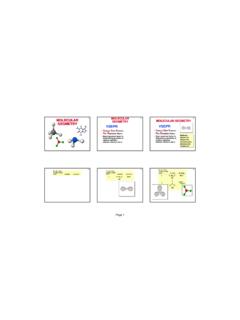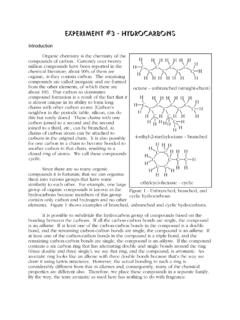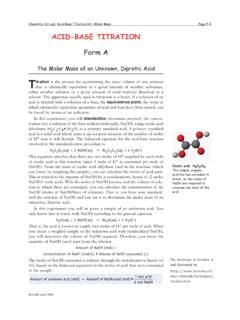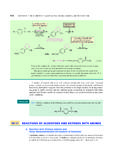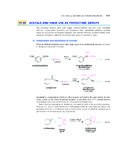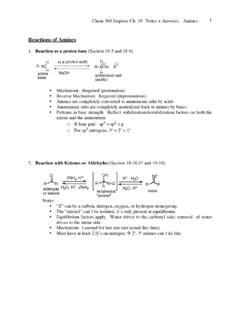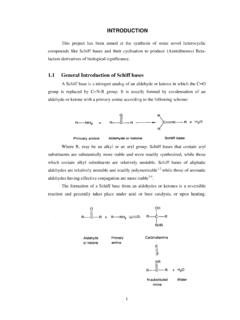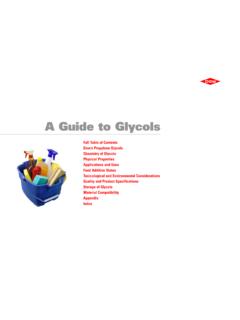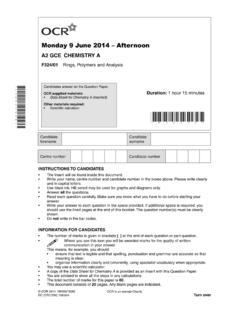Transcription of Experiment #9 – Identification of Aldehydes and Ketones
1 +Nucleophilic addition of 2,4-DNP toacetone. The curved arrows showelectron movement as bonds areformed and #9 Identification ofAldehydes and KetonesIntroductionAldehydes and Ketones share the carbonyl functional group which features carbondoubly bonded to oxygen. In the case of Ketones there are two carbon atoms bonded tothe carbonyl carbon and no hydrogens. In the case of Aldehydes there is at least onehydrogen bonded to the carbonyl carbon; the other attachment may be to a carbon or ahydrogen. In all cases the carbon(s) that are attached to the carbonyl group may bealiphatic (not part of an aromatic ring) or aromatic (part of an aromatic ring). Since theyshare the carbonyl group, Aldehydes and Ketones share much of their chemistry, but theyare different enough to be considered different classes of compounds. This situation issimilar to that of alcohols and phenols which both share the -OH and Ketones both undergo a reaction type known as nucleophilicaddition.
2 Under less acidic conditions, in this type of reaction a nucleophile (a speciesthat can donate a pair of electrons, in other words a Lewis base) donates a pair ofelectrons toward the carbonyl carbon forming a single bond to it. At the same time thedouble bond between the carbonyl carbon and oxygen becomes a single bond as onebonding pair of electrons in the double bond moves to become an unshared pair on theoxygen. The oxygen now has one bond to it and it holds three pairs of unsharedelectrons, so it has a negative charge. Consequently, the oxygen picks up a proton fromsomewhere (possibly one that was attached to the nucleophilic atom that attacked thecarbonyl carbon) and becomes an -OH group. Under more acidic conditions the resultsare pretty much the same, but the sequence in which they happen is more or lessreversed. In this case, a proton (from an acid) attaches itself to one of the unshared pairsof electrons on the oxygen.
3 The carbonyl group now has a +1 charge and is very invitingto even a weak nucleophile. [You can t have a strong nucleophile in an appreciablyacidic solution because strong nucleophiles are moderate to strong bases and moderateto strong bases don t hang out in acidic solutions.] So, a nucleophile attacks the carbonylcarbon forming a bond and the doubly bonded oxygen of the carbonyl becomes an -OH,as before. Both of these scenarios are sketched out below, using specific case less acidic solution: reaction of 2,4-dinitrophenylhydrazine with #9 Identification of Aldehydes and KetonesPage 2H3 CCCH3 ONNHNO2NO2 HHH3O+H3 CCCH3 ONNHNO2NO2 HHHH2O+H3 CCCH3 NNHNO2NO2HH2O+H3 CCCH3 NNHNO2NO2+H3OH3 CCOHHOH2+H3 CCOHHH2O+H3 CCOHHOCH3H+OCH3HH3 CCOHHOCH3HH3 CCOHHH2O+HH2 OOCH3H3 CCOHH+a hemiacetalAs we shall see just below, this product is not usually the one that is isolated. Rather thisproduct undergoes an elimination reaction in which the -OH is removed from the carbonto which it is attached and the hydrogen is removed from the nitrogen immediately to theright, resulting in a double bond between the nitrogen and carbon and a molecule ofwater.
4 The final product is known as a 2,4-dinitrophenylhydrazone. You ll be reactingaldehydes and Ketones with 2,4-dinitrophenylhydrazine to make 2,4-dinitrophenylhydrazones in this that an acid, H3O+, is needed as a catalyst in the first reaction above; it forms amolecule of water as one of the products in the first step. In the second step a secondmolecule of water is produced, but this water molecule is shown getting protonated inthe third step to produce H3O+, so it is used up. Consequently only one molecule ofwater is produced overall. Also note that the H3O+ that is used in the first step isreformed in the third step; this is the nature of a catalyst it speeds up a reaction, but isnot consumed in the case more acidic solution: reaction of methanol with #9 Identification of Aldehydes and KetonesPage 3HH2 OOCH3H3 CCOHH+a hemiacetalOCH3H3 CCOHHHH2O+OCH3H3 CCOHHHOCH3H3 CCHOCH3H3 CCHHOCH3 HOCH3 OCH3H3 CCHHOCH3 OCH3H3 CCHH2 OHH2 OOCH3 OCH3H3 CCH++++H2 Oan acetalIn the first step of this mechanism the acid catalyst, H3O+, protonates the oxygen of thecarbonyl group giving it a +1 charge.
5 In the second step, the weakly nucleophilicoxygen of methanol donates a pair of electrons toward the carbon of the carbonyl groupto form a new bond. In the third step the protonated hemicacetal transfers a proton tothe water molecule formed in the first step to give the hemiacetal and a hydronium ion. Note that the hydronium ion that was used in the first step is regenerated in the thirdstep; it is not consumed. This reaction is acid catalyzed. If the acetaldehyde were notprotonated by the acid in the first step, its reaction with methanol would be extremelyslow because methanol is a weak , the products of reactions between alcohols and either Aldehydes orketones, are important in carbohydrate chemistry. Sugars are, for the most part,polyhydroxy Aldehydes and Ketones . So, a sugar has both of the functional groups thatreact together to form a hemiacetal. It turns out that hemiacetals can react with alcohols to give compounds known asacetals.
6 Acetals have a tetrahedral carbon that has two oxygens bonded to it with theoxygens, in turn, being bonded to other carbon atoms. This reaction is also important incarbohydrate chemistry and an example is shown below. We will again use methanol asthe alcohol and the hemiacetal that was formed of which mechanism actually operates, these reactions are usuallyreferred to as nucleophilic #9 Identification of Aldehydes and KetonesPage 4Cr+3,greencarboxylicacidchromic acidbrown-orangealdehyde++++53323 RCOOHH2 OCr2(SO4)3H2SO4H2 CrO4 RCOH silvermetalTollens' reagent++++322H2 ONH3 RCOO NH4ammonium saltof carboxylic acidAgoAg(NH3)2 OHRCOH aldehydeRCOCH3 RCOO NaI2 NaOHNaIH2 OCHI3(s)3433+++++methy ketoneiodoform,yellow solidAldehydes are oxidized by chromic acid, Ketones are not. When an aldehyde isoxidized by orange-brown chromic acid the chromic acid is reduced to Cr+3, which isgreen. Consequently, chromic acid can distinguish between Aldehydes and Ketones .
7 It is also true that other functional groups, primary and secondary alcohols for example,can be oxidized by chromic acid, causing the formation of a green are also oxidized by Tollens reagent, a substance that contains Ag+1. The silver ion is, concomitantly, reduced to metallic silver. Silver ion is a weak oxidizingagent; Aldehydes are very easily oxidized and are essentially unique in being able toreduce silver ion to silver Ketones , but not other Ketones , are oxidized by iodine in aqueous sodiumhydroxide. The ketone is oxidized to a carboxylic acid; yellow iodoform also forms. It isthe yellow iodoform that is indicative of a positive test. Acetaldehyde, but not otheraldehydes, give this test owing to its structural similarity to methyl Ketones . It is also truethat ethanol (oxidized to acetaldehyde) and secondary alcohols that can be oxidized tomethyl Ketones give this objectives of this Experiment are to learn some of the chemistry of Aldehydes andketones and to use that knowledge to distinguish among some carbonyl compoundsbased on their #9 Identification of Aldehydes and KetonesPage 5 Caution!
8 Chromic acid is toxic and corrosive. If you get any on yourself, wash it off with lots ofwater. As usual, wear goggles to protect your !Dispose of the Tollens reagent by washing it down the drain with lots of water assoon as you re done using it. Likewise, wash the contents of the test tubes down thedrain as soon as you re done with the tests. Upon standing Tollens reagent canform an explosive compound. As usual, wear : Acetone, often used to clean and dry laboratory glassware, is a methylketone and must be removed from the glassware before a ring stand, ring, wire gauze, microburner, and a beaker that willconveniently hold 5 test tubes, set up a water bath that you can maintain at five test tubes as follows: (1) 3-methylbutanal (aliphatic aldehyde), (2)benzaldehyde (aromatic aldehyde), (3) cyclohexanone ( ketone ), (4) propanone akaacetone (methyl ketone ), (5) unknown. In each of the following tests start with 5drops of the corresponding compound in the test Chromic Acid Test Add 4 drops of chromic acid solution, agitating the tube after each addition.
9 Letstand for 10 minutes. Note any color change and approximately how long it takes tooccur. Record your Tollens Test Prepare the Tollens reagent in a 25 ml Erlenmeyer flask by mixing 5 ml of 9%aqueous silver nitrate with 5 ml of 10% aqueous sodium hydroxide. To the resultingmixture add 10% aqueous ammonia, dropwise with shaking, until the brown precipitateof silver oxide just dissolves; do not add excess the Tollens test to work well the test tubes in which it is conducted must bevery clean water must form a sheet on the glass, not drops. They do not have to the 5 drops of compound you added to each of the test tubes in bis(2-ethoxyethyl)ether by adding this solvent dropwise, with agitation, until a homogeneoussolution is obtained. Then add 2 ml of Tollens reagent and agitate. Place the tubes intoa 60oC water bath for 5 minutes. A positive test for an aldehyde will be a silver mirrorformed on the test tube if the test tube was clean; if the test tube was not clean, a blackprecipitate will form.
10 Record your results on the report sheet. Clean the test tubes with 1M nitric #9 Identification of Aldehydes and KetonesPage 63. Iodoform Test To each of the test tubes containing the compounds to be tested, add 2 ml ofwater and agitate. If the compound is not soluble, add dioxane dropwise with agitationuntil the mixture is homogeneous. Add 2 ml of 6 M aqueous sodium hydroxide. Agitate. Place the tubes into a 60oC water bath for 3 or 4 minutes and, leaving the tubes in thebath, add the iodine-potassium iodide solution dropwise with occasional agitation (toagitate, remove the tube from the bath momentarily) until the brown color persists for 2minutes in the tube. Add 6 M aqueous sodium hydroxide, dropwise with agitation, untilthe brown color dissipates. Keep the tubes in the water bath for 5 minutes. Remove thetubes from the bath and observe the contents. You are looking for a yellow precipitateof iodoform, indicative of acetaldehyde or a methyl ketone .



